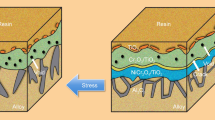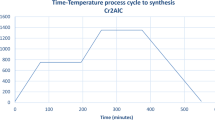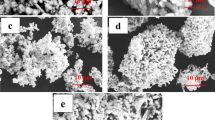Conclusions
-
1.
Type, composition, and amount of carbide phases formed in Ni−Mo alloys depends, not only on the molybdenum and carbon contents, but also on the presence of other elements (V, Fe), impurities (C, Si), and reducing agents, and also on heat treatment.
-
2.
In the alloy containing 26–31% Mo, 0.01–0.03% C, (0.1% Si, 0.2% Fe) the main carbide phase is an M12C-type carbide with lattice parametera=1.083–1.089 nm, containing not only Mo and Ni but also V and Ti (substituting for Mo in the lattice) and Fe and Si (substituting for Ni). In the 600–800°C temperature range, fully dispersed carbides precipitate along grain boundaries.
-
3.
Silicon initiates precipitation of the silicon-containing carbide phases, including their precipitation along grain boundaries at 800°C. Silicon also acts as a stabilizer for the carbide of M12C type, with lattice parametera=1.094–1.098 nm.
Similar content being viewed by others
Literature cited
T. V. Svistunova, “Corrosion-resistant nickel alloys,” Metalloved. Term. Obrab. Met., No. 7, 24–29 (1980).
G. Flint, J. Inst. Met.87, No. 9, 303–310 (1959).
T. V. Svistunova, Z. K. Runova, and A. A. Sakharov, “Corrosion of Ni−Al alloys,” Metalloved. Term. Obrab. Met., No. 5, 2–6 (1970).
T. V. Svistunova, V. I. Kirienko, L. P. Potapov, et al., “Influence of V and Nb on corrosion behavior of alloy N70M27 through ordering of its structure,” Metalloved. Term. Obrab. Met., No. 2, 33–39 (1973).
A. Fracker and H. Stadelamair, Trans. Met. Soc. AIME,245, No. 4, 847–850 (1969).
C. Heijrvegen and G. Rieck, Met. Trans.,4, No. 9, 2159–2162 (1973).
G. Lai, Met. Trans.,9A, No. 6, 827–833 (1978).
H. Beatte and F. Snyder, Trans. Am. Soc. Met.,49, No. 7, 883–886 (1957).
E. S. Makarov, “On one interesting chemical characteristic of conglomerates of structurally equivalent atomic positions in crystals,” in: Ideas of E. S. Fedorov in Modern Crystallography and Mineralogy [in Russian], Nauka, Leningrad (1970), p. 244.
E. S. Makarov, Isomorphism of Atoms in Crystals [in Russian], Atomizdat, Moscow (1973).
R. Ruo, Acta Metal.,1, No. 5, 301–304 (1953).
A. Bagshaw, Kristallografia,144, No. 1-2, 53–63 (1976).
E. N. Kislyakova, “Identifcation of structure and composition of double carbides, W-Co-C system using straight Debyegram lines method,” Zh. Fiz. Khim.,17, No. 2, 108–114 (1943).
A. Taylor and K. Sachs, Nature,169, No. 3, 411 (1952).
B. Piercey and R. Smashey, Trans. AIME,239, No. 4, 451–457 (1967).
M. Godden and J. Beech, J. Iron Steel Inst.,208, No. 2, 168–171 (1970).
J. Leitnaker, G. Rotter, D. Bradley, J. Franklin, Met. Trans.,9A, No. 3, 397–400 (1978).
E. Parthe and V. Sadagopan, Acta Cryst.,16, No. 3, 202–205 (1963).
M. Eddine, E. Bertaut, and J. Paris, Acta Cryst.,33, No. 10, 3010–3013 (1977).
E. I. Gladishevskii and L. Ya. Borusevich, “Ternary system Cr−Ni−Si,” J. Nonorganic Chem.,8, No. 8, 1915–1920 (1963).
T. Mukherjee and D. Dyson, J. Iron Stee. Inst.,210, No. 3, 203–205 (1972).
M. A. Krishtal, Diffusion Processes in Iron Solutions [in Russian], Metallurgizdat, Moscow (1963).
O. A. Bannikh, “On mechanism of silicon influence on carbide precipitation,” Fiz.-Khim. Mekh. Mater.,27, No. 5, 837–841 (1969).
Additional information
P. P. Bardin Central Research Institute of Ferrous Metals. Translated from Metallovedenie i Termicheskaya Obrabotka Metallov, No. 2, pp. 21–25, February, 1984.
Rights and permissions
About this article
Cite this article
Svistunova, T.V., Tsvigunov, A.N., Stegnukhina, L.V. et al. Influence of composition and heat treatment on carbide phases in Ni−Mo alloys. Met Sci Heat Treat 26, 119–124 (1984). https://doi.org/10.1007/BF00707159
Issue Date:
DOI: https://doi.org/10.1007/BF00707159




